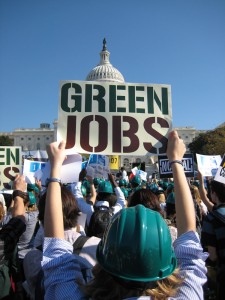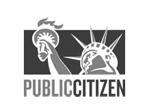“Regulation kills jobs.” This is the U.S. Chamber’s favorite go-to line, not because it’s accurate, but because it plays off of people’s fears, making it easy to believe—unless you check your facts.
The truth is that regulation is good for the environment and for the economy, but the U.S. Chamber, a long-time mouth piece  for multinational corporations and the Dirty Energy industry, doesn’t want you to know that. It’s major concern is protecting the profit margins of its wealthiest members, and those members don’t want to pay to clean up the pollution that they’re spilling into our air, water and soil. Check out what Yes! Magazine has to say about this issue, in their recent article posted below:
for multinational corporations and the Dirty Energy industry, doesn’t want you to know that. It’s major concern is protecting the profit margins of its wealthiest members, and those members don’t want to pay to clean up the pollution that they’re spilling into our air, water and soil. Check out what Yes! Magazine has to say about this issue, in their recent article posted below:
There’s an old adage that if you repeat a lie often enough, people will believe it. That seems to be the unofficial motto of the United States Chamber of Commerce, which has spent the last forty years repeating (and repeating and repeating) the mantra that government regulations on businesses “kill jobs” and economic growth. But their predictions have been repeatedly wrong. The laws they warned would bring economic ruin have become the basic health, safety, and environmental safeguards we now take for granted.
The Chamber’s latest goal is to prevent implementation of regulations to limit greenhouse gases and toxic air pollutants (as mandated by the Supreme Court). Republican proposals to eliminate the EPA’s authority to regulate greenhouse gasses failed in the Senate. Now they are focused on the Obama administration to thwart the EPA’s rule making process. The EPA recently proposed several regulations to address greenhouse gases, toxic emissions, and other pollutants from power plants..
The Chamber is hoping that in these hard economic times, Americans’ concern about jobs will scare them into believing that rules to limit global warming will stifle job growth. But their rhetoric is the same when the economy is humming. Whether unemployment is high or low, the Chamber and its business allies have opposed every significant step towards a more sustainable, healthier future. They opposed the Kyoto treaty, the Clean Air Act, auto emission standards, Renewable Portfolio Standards, the Clean Water Act, removing lead from gasoline and more. They justify their opposition by claiming that these rules will kill jobs. And they are wrong every time.
Let’s take a closer look at the last significant legislation tackling air pollution: the 1990 amendments to the Clean Air Act. It was a far-reaching bill that tightened pollution standards from autos and trucks as well as polluting industries. It created new rules requiring cleaner gasoline and diesel fuel and new standards to reduce toxic air pollutants. It also launched the Acid Rain Program, a cap and trade system limiting the production of sulfur dioxide and nitrogen oxides.
The proposals had lots of enemies. To lead the charge, industry lobbies created the Orwellian Clean Air Working Group, which claimed to represent 2000 business and trade associations. They predicted the bill would be the “quiet death for business across the country.” Conservative economist Milton Friedman wrote in the Wall Street Journal that “The Clean Air Act’s unduly stringent and extremely costly provisions could seriously threaten this nation’s economic expansion.” The National Association of Manufacturers, with newfound concern for the planet, claimed the Act’s provisions would hurt the economy “with no real assurance they would be balanced by a cleaner, healthier environment.”
Thanks to widespread public concern about the environment and grassroots organizing by environmental groups, the law passed anyway. We can now look back at the claims to see that the business lobbyists were wrong. The new law didn’t hurt the economy, and it did help the environment. Corporate America was just crying wolf:
- A 1990 study sponsored by the U.S. Business Roundtable (comprised of the CEOs of some of the nation’s largest corporations), claimed there was “…little doubt that a minimum of 200,000 (plus) jobs will be quickly lost, with plants closing in dozens of states. This number could easily exceed 1 million jobs—and even 2 million jobs—at the more extreme assumptions about residual risk.”Wrong. Studies done since the law passed show that actual job reductions were limited to one to three thousand jobs per year, with environmental jobs increasing by the tens of thousands each year.
- In May 1989, Ford Motor Company testified that “we just do not have the technology to comply” with the first tier of new tailpipe standards in the 1990 amendments, not even with technology “on the horizon.” They claimed that the proposed emission standards would be financially ruinous.Wrong. The motor vehicle industry began making vehicles that met the new standards in 1993.
- Oil companies predicted disaster. In October 1990, Mobil Corporation opposed the new Clean Air Act requirements for reformulated gasoline, writing that “the technology to meet these standards simply does not exist today” and predicting “major supply disruptions.”Wrong: Reformulated gasoline requirements went into effect without significant supply disruptions, and today reformulated gasoline costs just pennies more than conventional gasoline.
- The air conditioning and refrigerator lobby, too, predicted chaos. In January 1990, the DuPont Company testified the phase-out of ozone-depleting CFCs would cause “severe economic and social disruption.” The Air-Conditioning and Refrigeration Institute testified that it was “certain” that “the large installed inventory which we depend upon in this country cannot survive. … We will see shutdowns of refrigeration equipment in supermarkets. … We will see shutdowns of chiller machines, which cool our large office buildings, our hotels, and hospitals.”Wrong: The phase-out of CFC production was accelerated to December 31, 1995, with industry rapidly developing alternatives and none of the severe dislocation predicted by industry taking place.
- Then there was the bill’s acid rain program. It was the same kind of cap and trade that the Chamber of Commerce and Congressional Republicans are claiming will cost millions of jobs, wreck the economy, and send us back to the dark ages. In 1987, The National Association of Manufacturers complained that “Initiatives such as the acid rain legislation would, in this respect, achieve only the dubious distinction of moving the United States towards the status of a second-class industrial power by the end of the century.” Edward Addison, president of the Southern Co., an Atlanta-based electrical utility, complained in 1989 that the Acid Rain Program “will increase the cost, risk the reliability of electric service, disrupt the long-range planning of utilities, frustrate the regulatory process and foreclose the use of clean coal technologies.”Wrong again. Despite industry estimates that electricity rates would increase 10 percent or more, electricity prices actually fell in most states. Between 1990 and 2006, electricity prices fell by 47 percent in Arkansas, 32 percent in Georgia, 64 percent in Illinois, 28 percent in Indiana, 35 percent in Michigan, 30 percent in North Carolina, 18percent in Ohio, 36 percent in Pennsylvania, 40 percent in Utah, and 36 percent in Virginia. The business-oriented Economist magazine in 2002 called the acid rain program “probably the greatest green success story of the decade.”
Since the 1990 Amendments passed, polluting emissions have decreased, electricity generation continued to climb, and lakes and streams are cleaner. Industry responded by developing new technologies. The economy continued to grow.
Most importantly, people are healthier. Retrospective studies have found that the legislation prevented thousands of cases of bronchitis, heart attacks, and asthma. And it prevented millions of lost work and school days.
It’s clear now that the industry lobbies were crying wolf. The Chamber of Commerce and its allies today are hoping no that no one remembers. Let’s make them wrong—again.









